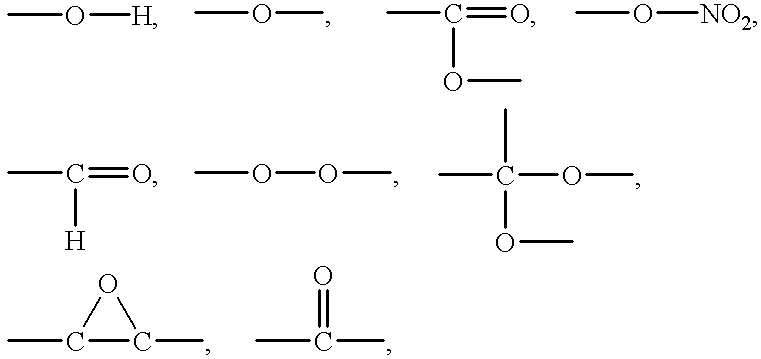Motor fuel for diesel, gas-turbine and turbojet engines
a technology for diesel engines and motor fuel, which is applied in the field of motor fuel, can solve the problems of reducing the inability to completely eliminate hydrocarbon mixtures in the inventory of vehicles and machinery with standard diesel, gas-turbine and turbojet engines, and the negative influence of global climate warming and on our planet, so as to reduce the emission of pollutants in the exhaust of engines
- Summary
- Abstract
- Description
- Claims
- Application Information
AI Technical Summary
Benefits of technology
Problems solved by technology
Method used
Image
Examples
example 1
[0107]Motor Fuel Composition 1 prepared below demonstrates that even when a very small quantity of organic compounds containing bound oxygen is employed, these compounds still provide a noticeable reduction of pollutants in the exhaust emissions of a standard diesel engine.
[0108]The content by volume of components in the Motor Fuel Composition 1 is as follows: formaldehyde diethyl acetal—1%; 1-butanol—1%; di-n-amyl ether—1.75%; octyl acetate—1%; isopropyl nitrate—0.25%; and hydrocarbon liquid (diesel fuel according to standard EN 590)—95%.
[0109]The fuel components were added to a common tank starting with the component with the lowest density and ending with the component having the greatest density. The resulting motor fuel composition had the following characteristics:
[0110]
Density at 20° C.0.811 g / cm3Temperature limits ofevaporation by boilingof the liquid atatmospheric pressureup to 100° C.1%up to 150° C.2.25%up to 200° C.14.5%up to 370° C.98.0%Heat of combustion42.8 MJ / kgTherma...
example 2
[0114]Motor Fuel Composition 2 produced a significant decrease of pollutants in the exhaust emissions of a standard diesel engine operating with an inexpensive fuel composition of organic compounds containing bound oxygen and a hydrocarbon liquid.
[0115]The content by volume of the components in Motor Fuel Composition 2 is as follows: ethanol—3%; 1-butanol—2.5%; dimethoxypropane—3%; tetrahydrofuran—1.5%; tert-butyl hydroperoxide—0.5%; and hydrocarbon liquid (Mk1 diesel fuel SS 15 54 35)—89.5%.
[0116]The fuel composition had the following characteristics:
[0117]
Density at 20° C.0.817 g / cm3Temperature limits ofevaporation by boilingof the liquid atatmospheric pressure:up to 100° C.8%up to 150° C.10.5%up to 200° C.19.5%up to 285° C.95.5%Heat of combustion41.9 MJ / kgThermal stabilityMotor Fuel Composition 2is a homogeneous liquid,stable at atmosphericpressure over a range oftemperatures from −30° C.(cloud temperature) to70° C. (initial boilingtemperature).
[0118]An analysis of the amount of ...
example 3
[0121]Motor Fuel Composition 3 produced a significant decrease of pollutants in the exhaust emissions of a standard diesel engine operating with an inexpensive fuel composition of organic compounds containing bound oxygen and a hydrocarbon liquid, which was a mixture of hydrocarbons obtained from a synthesis-gas “synthin”.
[0122]The content by volume of the components in Motor Fuel Composition 3 is as follows: ethanol—3%; 1-butanol—2.5%; dimethoxypropane—3%; ethyl acetate—1.5%; tert-butyl hydroperoxide—0.5%; and hydrocarbon liquid (hydrocarbon mixture obtained from synthesis-gas with catalyst under atmospheric pressure and temperatures of 170-200° C.)—89.5%.
[0123]The fuel composition had the following characteristics:
[0124]
Density at 20° C.0.817 g / cm3Temperature limits ofevaporation by boiling ofthe liquid at atmosphericpressure:up to 100° C.7%up to 150° C.10.5%up to 200° C.19.5%up to 285° C.95.5%Heat of combustion41.7 MJ / kgThermal stabilityMotor Fuel Composition 3is a homogeneous li...
PUM
| Property | Measurement | Unit |
|---|---|---|
| cloud temperature | aaaaa | aaaaa |
| boiling point | aaaaa | aaaaa |
| cloud temperature | aaaaa | aaaaa |
Abstract
Description
Claims
Application Information
 Login to View More
Login to View More - R&D
- Intellectual Property
- Life Sciences
- Materials
- Tech Scout
- Unparalleled Data Quality
- Higher Quality Content
- 60% Fewer Hallucinations
Browse by: Latest US Patents, China's latest patents, Technical Efficacy Thesaurus, Application Domain, Technology Topic, Popular Technical Reports.
© 2025 PatSnap. All rights reserved.Legal|Privacy policy|Modern Slavery Act Transparency Statement|Sitemap|About US| Contact US: help@patsnap.com



